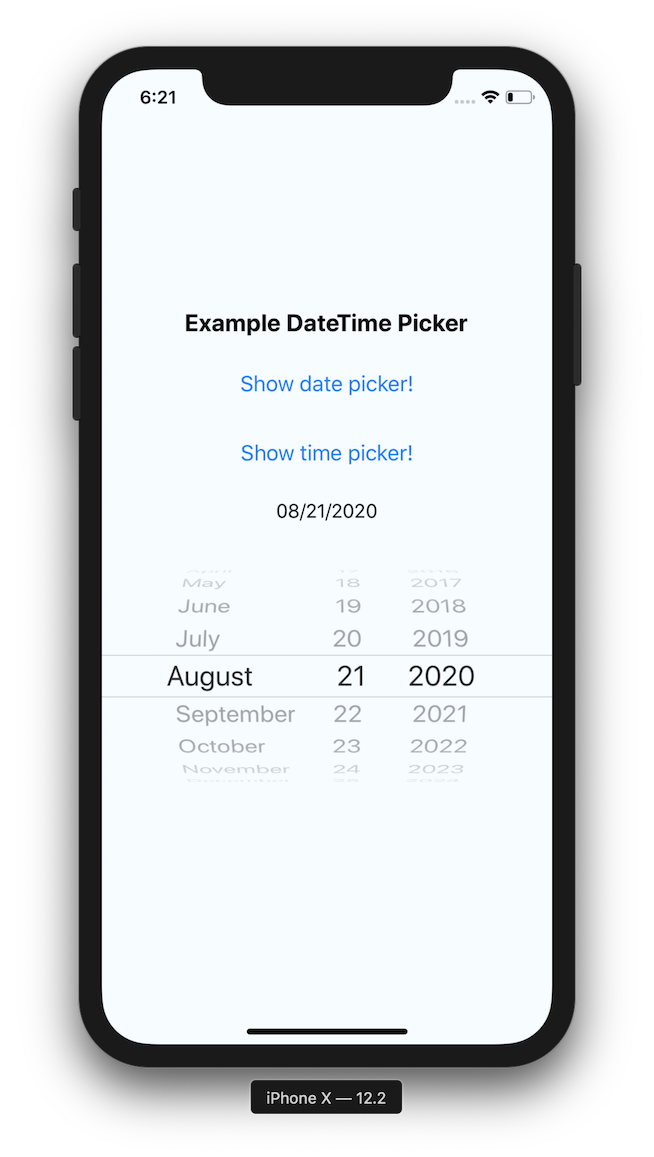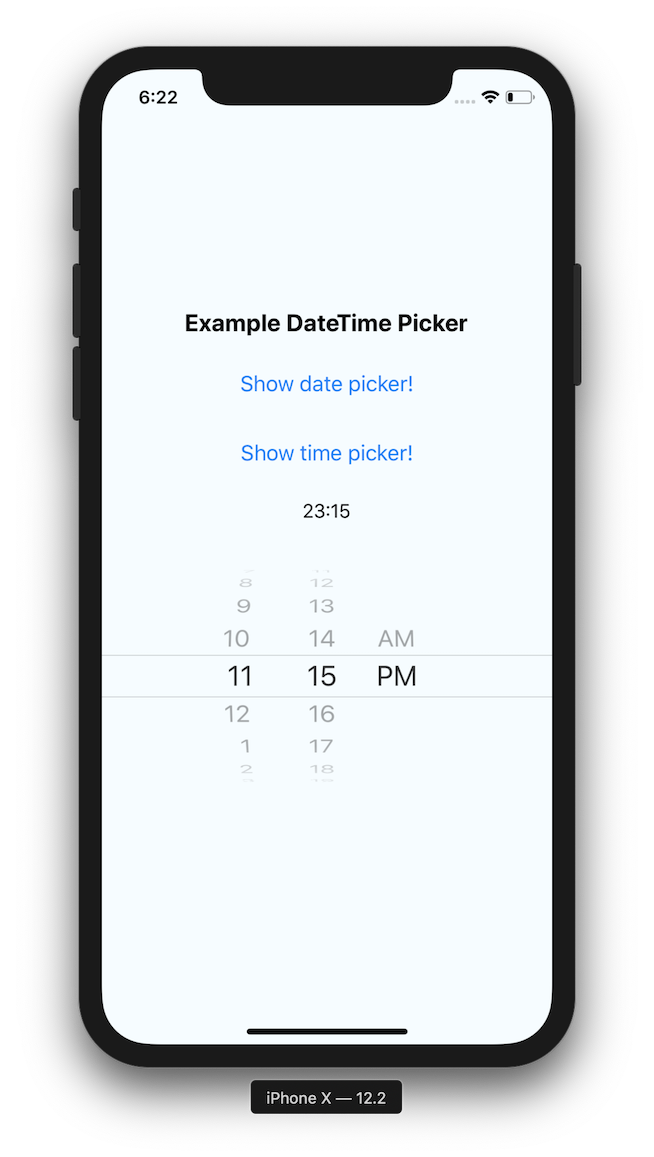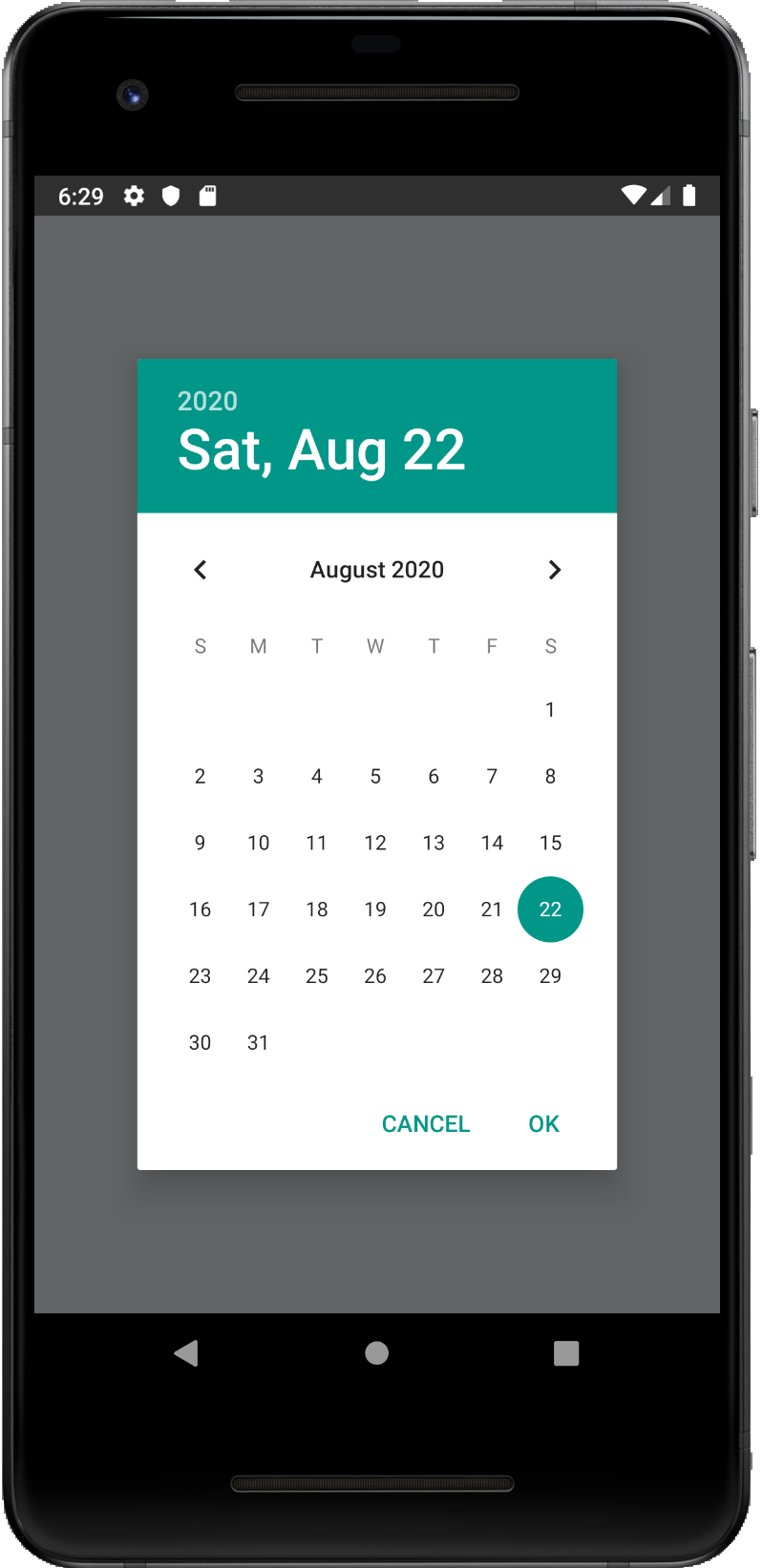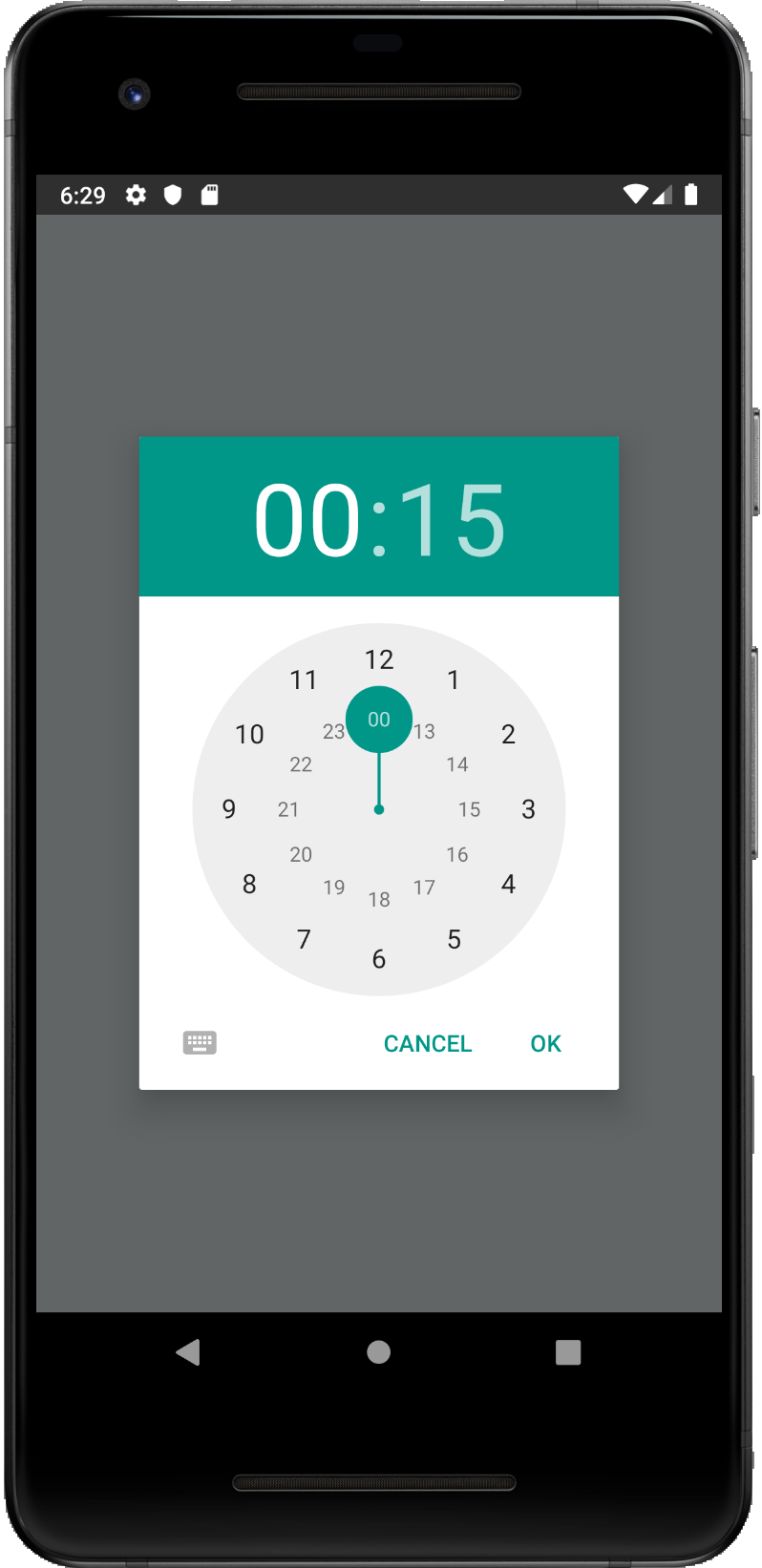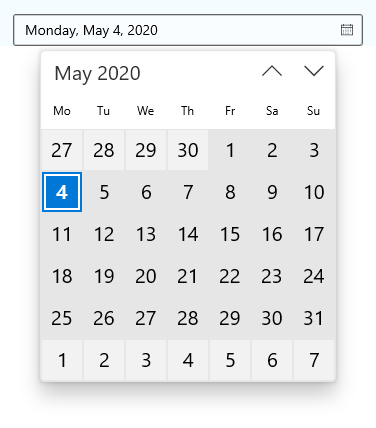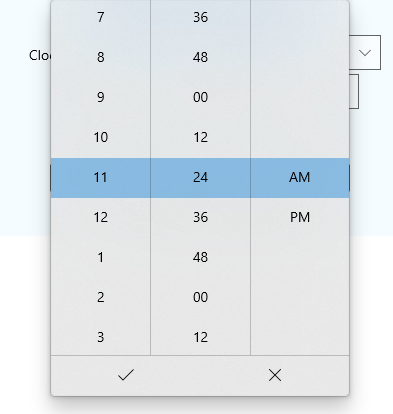See this issue
This repository was moved out of the react native community GH organization, in accordance to this proposal.
The module is still published on npm under the old namespace (as documented) but will be published under a new namespace soon, with a major version bump.
React Native date & time picker component for iOS, Android and Windows.
| iOS | |
| Android | |
| Windows | |
- React Native DateTimePicker
- Table of Contents
- Expo users notice
- Getting started
- General Usage
- Props
mode(optional)display(optional)onChange(optional)value(required)maximumDate(optional)minimumDate(optional)timeZoneOffsetInMinutes(optional,iOS or Android only)timeZoneOffsetInSeconds(optional,Windows only)dayOfWeekFormat(optional,Windows only)dateFormat(optional,Windows only)firstDayOfWeek(optional,Windows only)textColor(optional,iOS only)locale(optional,iOS only)is24Hour(optional,Windows and Android only)neutralButtonLabel(optional,Android only)minuteInterval(optional)style(optional,iOS only)disabled(optional,iOS only)
- Migration from the older components
- Contributing to the component
- Manual installation
- Running the example app
- Xcode >= 11.6
This module is part of Expo - see docs. However, Expo SDK may not contain the latest version of the module and therefore, the newest features and bugfixes may not be available in Expo. Use the command expo install @react-native-community/datetimepicker (not yarn or npm) to install this module - Expo will automatically install the latest version compatible with your Expo SDK (which may not be the latest version of the module available).
npm install @react-native-community/datetimepicker --saveor
yarn add @react-native-community/datetimepickerAutolinking is not yet implemented on Windows, so Manual installation is needed.
If you are using RN >= 0.60, only run npx pod-install. Then rebuild your project.
For RN < 0.60, you need to link the dependency using react-native link:
react-native link @react-native-community/datetimepickerThen run npx pod-install and rebuild your project.
If this does not work, see Manual installation.
import DateTimePicker from '@react-native-community/datetimepicker';or
const DateTimePicker = require('@react-native-community/datetimepicker');import React, {useState} from 'react';
import {View, Button, Platform} from 'react-native';
import DateTimePicker from '@react-native-community/datetimepicker';
export const App = () => {
const [date, setDate] = useState(new Date(1598051730000));
const [mode, setMode] = useState('date');
const [show, setShow] = useState(false);
const onChange = (event, selectedDate) => {
const currentDate = selectedDate || date;
setShow(Platform.OS === 'ios');
setDate(currentDate);
};
const showMode = (currentMode) => {
setShow(true);
setMode(currentMode);
};
const showDatepicker = () => {
showMode('date');
};
const showTimepicker = () => {
showMode('time');
};
return (
<View>
<View>
<Button onPress={showDatepicker} title="Show date picker!" />
</View>
<View>
<Button onPress={showTimepicker} title="Show time picker!" />
</View>
{show && (
<DateTimePicker
testID="dateTimePicker"
value={date}
mode={mode}
is24Hour={true}
display="default"
onChange={onChange}
/>
)}
</View>
);
};Please note that this library currently exposes functionality from
UIDatePickeron iOS and DatePickerDialog + TimePickerDialog on Android, andCalendarDatePicker+TimePicker on Windows.These native classes offer only limited configuration, while there are dozens of possible options you as a developer may need. It follows that if your requirement is not supported by the backing native views, this library will not be able to implement your requirement. When you open an issue with a feature request, please document if (or how) the feature can be implemented using the aforementioned native views. If those views do not support what you need, such feature requests will be closed as not actionable.
Defines the type of the picker.
List of possible values:
"date"(default foriOSandAndroidandWindows)"time""datetime"(iOSonly)"countdown"(iOSonly)
<RNDateTimePicker mode="time" />Defines the visual display of the picker. The default value is "default".
List of possible values for Android
"default"- Show a default date picker (spinner/calendar/clock) based onmodeand Android version."spinner""calendar"(only fordatemode)"clock"(only fortimemode)
List of possible values for iOS (maps to preferredDatePickerStyle)
"default"- Automatically pick the best style available for the current platform & mode."spinner"- the usual appearance with a wheel from which you choose values"compact"- Affects only iOS 14 and later. Will fall back to "spinner" if not supported."inline"- Affects only iOS 14 and later. Will fall back to "spinner" if not supported.
<RNDateTimePicker display="spinner" />Date change handler.
This is called when the user changes the date or time in the UI. It receives the event and the date as parameters.
setDate = (event, date) => {};
<RNDateTimePicker onChange={this.setDate} />;Defines the date or time value used in the component.
<RNDateTimePicker value={new Date()} />Defines the maximum date that can be selected. Note that on Android, this only works for date mode because TimePicker does not support this.
<RNDateTimePicker maximumDate={new Date(2300, 10, 20)} />Defines the minimum date that can be selected. Note that on Android, this only works for date mode because TimePicker does not support this.
<RNDateTimePicker minimumDate={new Date(1950, 0, 1)} />Allows changing of the timeZone of the date picker. By default it uses the device's time zone.
// GMT+1
<RNDateTimePicker timeZoneOffsetInMinutes={60} />Allows changing of the time zone of the date picker. By default it uses the device's time zone.
// UTC+1
<RNDateTimePicker timeZoneOffsetInSeconds={3600} />Sets the display format for the day of the week headers. Reference: https://docs.microsoft.com/en-us/uwp/api/windows.ui.xaml.controls.calendarview.dayofweekformat?view=winrt-18362#remarks
<RNDateTimePicker dayOfWeekFormat={'{dayofweek.abbreviated(2)}'} />Sets the display format for the date value in the picker's text box. Reference: https://docs.microsoft.com/en-us/uwp/api/windows.globalization.datetimeformatting.datetimeformatter?view=winrt-18362#examples
<RNDateTimePicker dateFormat="dayofweek day month" />Indicates which day is shown as the first day of the week.
<RNDateTimePicker firstDayOfWeek={DAY_OF_WEEK.Wednesday} />
// The native parameter type is an enum defined in defined https://docs.microsoft.com/en-us/uwp/api/windows.globalization.dayofweek?view=winrt-18362 - meaning an integer needs to passed here (DAY_OF_WEEK).Allows changing of the textColor of the date picker. Has effect only when display is "spinner".
<RNDateTimePicker textColor="red" />Allows changing of the locale of the component. By default it uses the device's locale.
<RNDateTimePicker locale="es-ES" />Allows changing of the time picker to a 24 hour format. By default, this value is decided automatcially based on the user's chosen locale and other preferences.
<RNDateTimePicker is24Hour={true} />Allows displaying neutral button on picker dialog.
Pressing button can be observed in onChange handler as event.type === 'neutralButtonPressed'
<RNDateTimePicker neutralButtonLabel="clear" />The interval at which minutes can be selected.
Possible values are: 1, 2, 3, 4, 5, 6, 10, 12, 15, 20, 30
(On Windows, this can be any number between 0-59.)
on iOS, this in only supported when display="spinner"
<RNDateTimePicker minuteInterval={10} />Sets style directly on picker component. By default, the picker height is fixed to 216px.
Please note that by default, picker's text color is controlled by the application theme (light / dark mode). In dark mode, text is white and in light mode, text is black.
This means that eg. if the device has dark mode turned on, and your screen background color is white, you will not see the picker. Please use the Appearance api to adjust the picker's background color so that it is visible, as we do in the example App or opt-out from dark mode.
<RNDateTimePicker style={{flex: 1}} />If true, the user won't be able to interact with the view.
RNDateTimePicker is the new common name used to represent the old versions of iOS and Android.
On Android, open picker modals will update the selected date and/or time if the prop value changes. For example, if a HOC holding state, updates the value prop. Previously the component used to close the modal and render a new one on consecutive calls.
-
initialDateis deprecated, usevalueinstead.// Before <DatePickerIOS initialValue={new Date()} />
// Now <RNDateTimePicker value={new Date()} />
-
dateis deprecated, usevalueinstead.// Before <DatePickerIOS date={new Date()} />
// Now <RNDateTimePicker value={new Date()} />
-
onChangenow returns also the date.// Before onChange = (event) => {}; <DatePickerIOS onChange={this.onChange} />;
// Now onChange = (event, date) => {}; <RNDateTimePicker onChange={this.onChange} />;
-
onDateChangeis deprecated, useonChangeinstead.// Before setDate = (date) => {}; <DatePickerIOS onDateChange={this.setDate} />;
// Now setDate = (event, date) => {}; <RNDateTimePicker onChange={this.setDate} />;
-
dateis deprecated, usevalueinstead.// Before try { const {action, year, month, day} = await DatePickerAndroid.open({ date: new Date(), }); } catch ({code, message}) { console.warn('Cannot open date picker', message); }
// Now <RNDateTimePicker mode="date" value={new Date()} />
-
minDateandmaxDateare deprecated, useminimumDateandmaximumDateinstead.// Before try { const {action, year, month, day} = await DatePickerAndroid.open({ minDate: new Date(), maxDate: new Date(), }); } catch ({code, message}) { console.warn('Cannot open date picker', message); }
// Now <RNDateTimePicker mode="date" minimumDate={new Date()} maximumDate={new Date()} />
-
dateSetActionis deprecated, useonChangeinstead.// Before try { const {action, year, month, day} = await DatePickerAndroid.open(); if (action === DatePickerAndroid.dateSetAction) { // Selected year, month (0-11), day } } catch ({code, message}) { console.warn('Cannot open date picker', message); }
// Now setDate = (event, date) => { if (date !== undefined) { // timeSetAction } }; <RNDateTimePicker mode="date" onChange={this.setDate} />;
-
dismissedActionis deprecated, useonChangeinstead.// Before try { const {action, year, month, day} = await DatePickerAndroid.open(); if (action === DatePickerAndroid.dismissedAction) { // Dismissed } } catch ({code, message}) { console.warn('Cannot open date picker', message); }
// Now setDate = (event, date) => { if (date === undefined) { // dismissedAction } }; <RNDateTimePicker mode="date" onChange={this.setDate} />;
-
hourandminuteare deprecated, usevalueinstead.// Before try { const {action, hour, minute} = await TimePickerAndroid.open({ hour: 14, minute: 0, is24Hour: false, // Will display '2 PM' }); if (action !== TimePickerAndroid.dismissedAction) { // Selected hour (0-23), minute (0-59) } } catch ({code, message}) { console.warn('Cannot open time picker', message); }
// Now // It will use the hour and minute defined in date <RNDateTimePicker mode="time" value={new Date()} />
-
timeSetActionis deprecated, useonChangeinstead.// Before try { const {action, hour, minute} = await TimePickerAndroid.open(); if (action === TimePickerAndroid.timeSetAction) { // Selected hour (0-23), minute (0-59) } } catch ({code, message}) { console.warn('Cannot open time picker', message); }
// Now setTime = (event, date) => { if (date !== undefined) { // Use the hour and minute from the date object } }; <RNDateTimePicker mode="time" onChange={this.setTime} />;
-
dismissedActionis deprecated, useonChangeinstead.// Before try { const {action, hour, minute} = await TimePickerAndroid.open(); if (action === TimePickerAndroid.dismissedAction) { // Dismissed } } catch ({code, message}) { console.warn('Cannot open time picker', message); }
// Now setTime = (event, date) => { if (date === undefined) { // dismissedAction } }; <RNDateTimePicker mode="time" onChange={this.setTime} />;
Please see CONTRIBUTING.md
-
Install CocoaPods, here the installation guide.
-
Inside the iOS folder run
pod init, this will create the initialpodfile. -
Update your
podfile to look like the following ( Remember to replaceMyAppwith your target name ):# Allowed sources source 'https://github.com/CocoaPods/Specs.git' target 'MyApp' do # As we use Swift, ensure that `use_frameworks` is enabled. use_frameworks! # Specific iOS platform we are targetting platform :ios, '8.0' # Point to the installed version pod 'RNDateTimePicker', :path => '../node_modules/@react-native-community/datetimepicker/RNDateTimePicker.podspec' # React/React-Native specific pods pod 'React', :path => '../node_modules/react-native', :subspecs => [ 'Core', 'CxxBridge', # Include this for RN >= 0.47 'DevSupport', # Include this to enable In-App Devmenu if RN >= 0.43 'RCTText', 'RCTNetwork', 'RCTWebSocket', # Needed for debugging ] # Explicitly include Yoga if you are using RN >= 0.42.0 pod 'yoga', :path => '../node_modules/react-native/ReactCommon/yoga' # Third party deps podspec link pod 'DoubleConversion', :podspec => '../node_modules/react-native/third-party-podspecs/DoubleConversion.podspec' pod 'glog', :podspec => '../node_modules/react-native/third-party-podspecs/glog.podspec' pod 'Folly', :podspec => '../node_modules/react-native/third-party-podspecs/Folly.podspec' end
-
Run
pod installinside the same folder where thepodfile was created -
npm run start -
npm run start:ios
-
Add the following lines to
android/settings.gradle:include ':@react-native-community_datetimepicker' project(':@react-native-community_datetimepicker').projectDir = new File(rootProject.projectDir, '../node_modules/@react-native-community/datetimepicker/android')
-
Add the compile line to the dependencies in
android/app/build.gradle:dependencies { ... implementation project(':@react-native-community_datetimepicker') }
-
Add the import and link the package in
MainApplication.java:+ import com.reactcommunity.rndatetimepicker.RNDateTimePickerPackage; public class MainApplication extends Application implements ReactApplication { @Override protected List<ReactPackage> getPackages() { @SuppressWarnings("UnnecessaryLocalVariable") List<ReactPackage> packages = new PackageList(this).getPackages(); // Packages that cannot be autolinked yet can be added manually here, for example: + packages.add(new RNDateTimePickerPackage()); return packages; } }
- Open the solution in Visual Studio 2019
- Right-click solution icon in Solution Explorer > Add > Existing Project Select 'D:\pathToYourApp\node_modules@react-native-community\datetimepicker\windows\DateTimePickerWindows\DateTimePickerWindows.vcxproj'
Add a reference to DateTimePickerWindows to your main application project. From Visual Studio 2019:
Right-click main application project > Add > Reference... Check 'DateTimePickerWindows' from the 'Project > Solution' tab on the left.
Add #include "winrt/DateTimePicker.h".
Add PackageProviders().Append(winrt::DateTimePicker::ReactPackageProvider()); before InitializeComponent();.
- Run
yarnin repo root - Run
cd example - Install required pods by running
npx pod-install - Run
yarn startto start Metro Bundler - Run
yarn run start:iosoryarn run start:androidoryarn run start:windows - To do any development on the library, open the example project (in the example folder!) in xCode or Android Studio. The example project depends on the library code, which you can edit and observe any changes in the example project.



